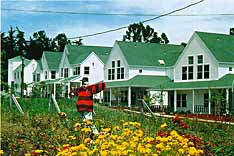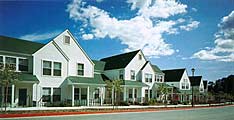 |
|
Project Summary: The Farm
DEVELOPER
Mid-Peninsula Housing Coalition
ARCHITECT
Seidel/Holzman
CONSULTANTS:
Landscape Architect: Anthony Guzzardo and Assoc.
Development Consultant: Community Economics
CONTRACTOR
Lyntrak Construction Co., Inc.
PROPERTY MANAGEMENT
Mid-Peninsula Hsg. Mgmt. Corp.
| FUNDERS: | TYPE: |
| SAMCO | Perm. loan |
| Union Bank | Constr. loan |
| Federal Low Income Hsg. Tax Credits Mission First Financial
| Equity |
| Santa Cruz County Redev. Agency | Grant |
| American Red Cross | Loan |
| California Department of HCD | Loan |
| Santa Cruz Co. Human Resources Agency | Childcare grant |
| Santa Cruz Co. Sanitation District | Loan |
| The Lions Club International | Predev. funds |
| Northern California Community Loan Fund | Predev. loan |
DEVELOPMENT TYPE:
Two-story rental townhouses and stacked flats, for-sale SF homes (mkt. rate).
RESIDENT PROFILE:
Very-low- and low-income families, incomes less than $31,200 (60% AMI).
Ave. income is $16,720. Families, incomes at or above median (SF homes).
DENSITY: 13 units per acre
DEVELOPMENT PROFILE
| Type | #/Units | Size (sf) | Rents |
| Single-family | 6 | 1,670-2,200 | $245,000-345,000 |
| 1 BR | 1 | 716 | $520 |
| 2 BR | 16 | 906 | $344-625 |
| 3 BR | 22 | 1180 | $372-695 |
| Total | 45 | | |
Childcare center: 2,016 (sf)
Parking : 99 surface (9 for daycare)
Total site area: 4.2 acres
|
CONSTRUCTION TYPE
Two-story woodframe, painted wood siding, comp. shingle roof.
DEVELOPMENT COSTS:
Land cost: $1,413,335; Constr. costs: $2,880,935; Other costs: $1,955,397;
Total development costs: $6,249,667 ($138,881/unit); Completed June 1993.
|
|
|
THE FARM, Soquel, California
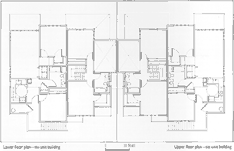 The Farm is the fortunate result of a compromise that matched community goals with those of a private developer and a non-profit sponsor of affordable housing. What began as a proposal by the owner/developer of an 11.5-acre former farmstead to develop the property into single family houses and a limited number of affordable rental apartments, ended with a development that provided the same amount of housing with 87 per cent of it affordable, a new park, a child care center, and lots for single family houses that were built for sale at market rate to help fund the affordable housing.
The Farm is the fortunate result of a compromise that matched community goals with those of a private developer and a non-profit sponsor of affordable housing. What began as a proposal by the owner/developer of an 11.5-acre former farmstead to develop the property into single family houses and a limited number of affordable rental apartments, ended with a development that provided the same amount of housing with 87 per cent of it affordable, a new park, a child care center, and lots for single family houses that were built for sale at market rate to help fund the affordable housing.
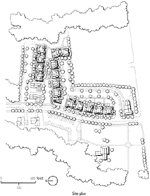 The original proposal failed to gain approval because it did not preserve the character of the area or the rural setting with its grasslands, views of oak woodlands, and riparian vegetation along a creek. As an alternative, the Mid-Peninsula Housing Coalition (MPHC), working with Green Farm Limited Partners, the owners of the 11.5-acre site, and the Santa Cruz County Redevelopment Agency proposed a master plan for the property. The redevelopment agency purchased most of the site; the Lion's Club provided funds for a childcare center and construction; and other agencies assisted in various ways. The old farmhouse stands across the street from the new white-painted, wooden buildings with gable roofs and front porches that reflect its architecture character.
The original proposal failed to gain approval because it did not preserve the character of the area or the rural setting with its grasslands, views of oak woodlands, and riparian vegetation along a creek. As an alternative, the Mid-Peninsula Housing Coalition (MPHC), working with Green Farm Limited Partners, the owners of the 11.5-acre site, and the Santa Cruz County Redevelopment Agency proposed a master plan for the property. The redevelopment agency purchased most of the site; the Lion's Club provided funds for a childcare center and construction; and other agencies assisted in various ways. The old farmhouse stands across the street from the new white-painted, wooden buildings with gable roofs and front porches that reflect its architecture character.
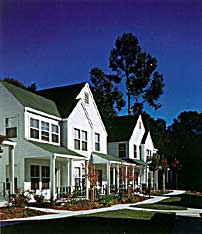 This was the first major new rental housing development for families with low incomes in the area since 1989. Applicants living or working in Santa Cruz County were given preference, and all those now living at The Farm were already residents of the county. The thirty-nine units are mainly in two- and three-bedroom townhouses with separate entrances leading to semi-private yards and/or to front porches. The common open space was configured to provide a view corridor to the riparian landscape east of the development. Smaller buildings with two- bedroom units occupy sites visible from Cunnison Lane and Soquel Drive; larger apartment buildings with six units are located toward the back of the development area where they are less visible from the streets. Differences in building size are minimized visually by articulating their forms in similar ways.
This was the first major new rental housing development for families with low incomes in the area since 1989. Applicants living or working in Santa Cruz County were given preference, and all those now living at The Farm were already residents of the county. The thirty-nine units are mainly in two- and three-bedroom townhouses with separate entrances leading to semi-private yards and/or to front porches. The common open space was configured to provide a view corridor to the riparian landscape east of the development. Smaller buildings with two- bedroom units occupy sites visible from Cunnison Lane and Soquel Drive; larger apartment buildings with six units are located toward the back of the development area where they are less visible from the streets. Differences in building size are minimized visually by articulating their forms in similar ways.
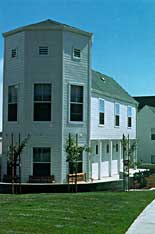 Parking is located on private streets behind the buildings with two entrance points off Cunnison Lane. The original number of parking spaces required by the county was reduced because automobile ownership is not only lower than in the average residential tract but the MPHC management has also developed a parking management plan through experience in other developments, which controls parking needs through screening of applicants and strict enforcement, aided by resident stickers.
Parking is located on private streets behind the buildings with two entrance points off Cunnison Lane. The original number of parking spaces required by the county was reduced because automobile ownership is not only lower than in the average residential tract but the MPHC management has also developed a parking management plan through experience in other developments, which controls parking needs through screening of applicants and strict enforcement, aided by resident stickers.
A childcare center located at the intersection of Cunnison Lane and Soquel Drive is operated by a local non-profit organization, Growth and Opportunity, Inc. The center receives state and federal subsidies as well as funds from the development to ensure that fees are affordable for residents of The Farm and the surrounding community who need child care. Housed in a one-story building the center shares parking and vehicle access with the adjacent housing. During evenings and on weekends the building serves as a community meeting place.
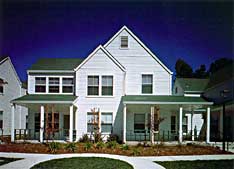 The architects held meetings with interested neighbors and members of the community to address their concerns. The initial opposition to the development vanished when people saw and liked the design. Since its completion The Farm has won several awards for design excellence and is perceived by neighbors as being attractive and well-managed. The single- family houses that were built as part of the master plan sold easily for good prices, demonstrating that the prospect of affordable rental housing did not devalue the neighborhood. One neighbor commented that her attitude toward housing for people with low incomes had changed because of her experience with the development:
The architects held meetings with interested neighbors and members of the community to address their concerns. The initial opposition to the development vanished when people saw and liked the design. Since its completion The Farm has won several awards for design excellence and is perceived by neighbors as being attractive and well-managed. The single- family houses that were built as part of the master plan sold easily for good prices, demonstrating that the prospect of affordable rental housing did not devalue the neighborhood. One neighbor commented that her attitude toward housing for people with low incomes had changed because of her experience with the development:
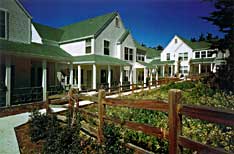 "Before we moved into the neighborhood we wanted to consider the potential effect of The Farm on property values, crime, and so forth. Mid-Peninsula Housing arranged for us to visit five of their similar housing developments. We met with residents and property managers and got a very good idea of the way the housing was managed and the type of people they housed. I also worked closely with my realtor to research recent sales in the areas around those developments. We discovered that in all cases property values remained the same or increased--the situations were no different than in areas without affordable housing. So we felt very comfortable purchasing a house next to The Farm."
"Before we moved into the neighborhood we wanted to consider the potential effect of The Farm on property values, crime, and so forth. Mid-Peninsula Housing arranged for us to visit five of their similar housing developments. We met with residents and property managers and got a very good idea of the way the housing was managed and the type of people they housed. I also worked closely with my realtor to research recent sales in the areas around those developments. We discovered that in all cases property values remained the same or increased--the situations were no different than in areas without affordable housing. So we felt very comfortable purchasing a house next to The Farm."
|






